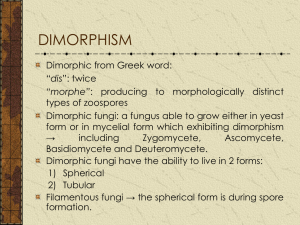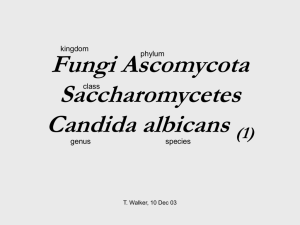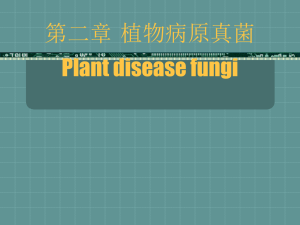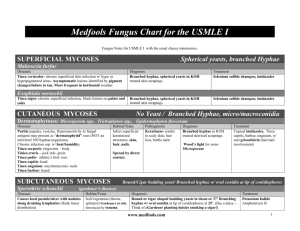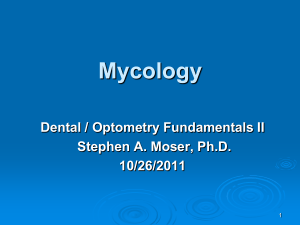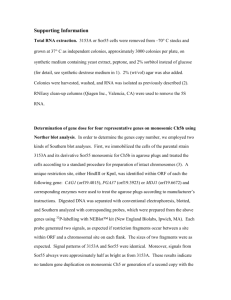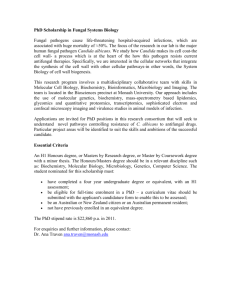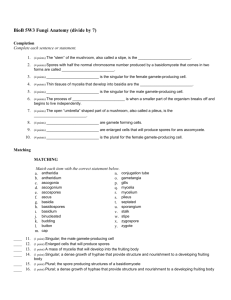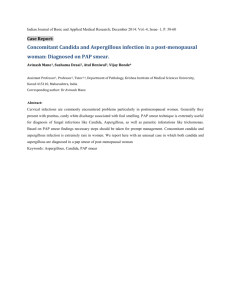Cutaneous Fungal Infections
advertisement
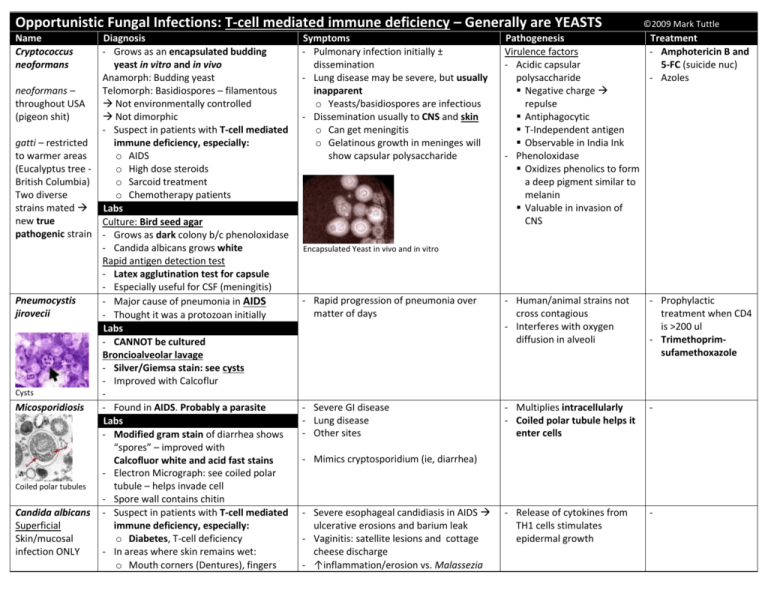
Opportunistic Fungal Infections: T-cell mediated immune deficiency – Generally are YEASTS Name Cryptococcus neoformans Diagnosis - Grows as an encapsulated budding yeast in vitro and in vivo Anamorph: Budding yeast neoformans – Telomorph: Basidiospores – filamentous throughout USA Not environmentally controlled (pigeon shit) Not dimorphic - Suspect in patients with T-cell mediated gatti – restricted immune deficiency, especially: to warmer areas o AIDS (Eucalyptus tree o High dose steroids British Columbia) o Sarcoid treatment Two diverse o Chemotherapy patients strains mated Labs new true Culture: Bird seed agar pathogenic strain - Grows as dark colony b/c phenoloxidase - Candida albicans grows white Rapid antigen detection test - Latex agglutination test for capsule - Especially useful for CSF (meningitis) Pneumocystis - Major cause of pneumonia in AIDS jirovecii - Thought it was a protozoan initially Labs - CANNOT be cultured Broncioalveolar lavage - Silver/Giemsa stain: see cysts - Improved with Calcoflur Cysts Micosporidiosis - Found in AIDS. Probably a parasite Labs - Modified gram stain of diarrhea shows “spores” – improved with Calcofluor white and acid fast stains - Electron Micrograph: see coiled polar Coiled polar tubules tubule – helps invade cell - Spore wall contains chitin Candida albicans - Suspect in patients with T-cell mediated Superficial immune deficiency, especially: Skin/mucosal o Diabetes, T-cell deficiency infection ONLY - In areas where skin remains wet: o Mouth corners (Dentures), fingers Symptoms - Pulmonary infection initially ± dissemination - Lung disease may be severe, but usually inapparent o Yeasts/basidiospores are infectious - Dissemination usually to CNS and skin o Can get meningitis o Gelatinous growth in meninges will show capsular polysaccharide ©2009 Mark Tuttle Pathogenesis Treatment Virulence factors - Amphotericin B and - Acidic capsular 5-FC (suicide nuc) polysaccharide - Azoles Negative charge repulse Antiphagocytic T-Independent antigen Observable in India Ink - Phenoloxidase Oxidizes phenolics to form a deep pigment similar to melanin Valuable in invasion of CNS Encapsulated Yeast in vivo and in vitro - Rapid progression of pneumonia over matter of days - Human/animal strains not cross contagious - Interferes with oxygen diffusion in alveoli - Prophylactic treatment when CD4 is >200 ul - Trimethoprimsufamethoxazole - Severe GI disease - Lung disease - Other sites - Multiplies intracellularly - Coiled polar tubule helps it enter cells - - Release of cytokines from TH1 cells stimulates epidermal growth - - Mimics cryptosporidium (ie, diarrhea) - Severe esophageal candidiasis in AIDS ulcerative erosions and barium leak - Vaginitis: satellite lesions and cottage cheese discharge - ↑inflammation/erosion vs. Malassezia Opportunistic Fungal Infections: Neutrophil immune deficiency – Generally are MOLDS Name Aspergillus fumigates, flavus, niger Septate hyphae, branching at 45° Zygomycetes Sporangiospores Diagnosis - Mold producing abundant blastoconidia on conidiophores - On composts and rotting plant materials - Septate branching hyphae; angiotrophic - Fusarium mimics growth pattern but is rare (Contact lenses) - More and more seen post bone marrow transplant - Sporegerm tubehyphae/mycelium Labs Culture: Grows very well at 45°C CT scan: Air crescent in lungs (except in people with absolutely no neutrophils) Biopsy Won’t see in blood sample usually! - Anamorphs: sporangiospores - Germinate to form hyphae/mycelium Wide, aseptate, irregular hyphae - Much rarer than Aspergillus - Can get coinfection with Aspergillus ©2009 Mark Tuttle Symptoms Pathogenesis Treatment - Infects via lungs unless injected somehow See air crescent - Newer azoles - Pulmonary phagocytes fail to kill spores in with high dose steroid treatment (Voriconazole/ - Hyphae branch (usually at 45°), expands and penetrates blood vessel walls Poscaonazole) Infarcts follow BV penetration replacing - Hyphae in lung present problem of size but normal neutrophils are effective amphotericin B at killing them with Reactive Oxygen, H2O2, Myeloperoxidase, and Cl - Treat on suspicion Non-neutropenic complications because of rapid - Aspergilloma: Grows in a ball in a pre-existing scarred cavity (TB/Sarcoid) progression Corrodes edge – danger of hemoptysis (coughing blood) Grows saprophytically outside the reach of the immune system Treatment: Need surgery See air crescent - Allergic bronchopulmonary aspergillosis Spores germinate in bronchioles and begin to grow Allergic mucus response leads to plugging of bronchioles. ABs ↑↑ Significantly reduced lung capacity Rhinocerebral zygomycosis - Infection via nasal turbinates and sinuses into CNS (lethal in brain) - ONLY diabetics with ketoacidosis Bone marrow transplant recipients - Get zygomacosis when given voriconazole/posaconazole prophylactically for Aspergillus - Usually via lung with dissemination, but can occur via GI and wounds - Hyphae are angiotrophic - Iron stimulates growth - Resistant to azoles, including resistance to newer azoles: Voriconazole/ Posconazole - MUST USE amphotericin B Aseptate hyphae Candida albicans Invasive Deep-seated, systemic Pseudohyphae Chlamydospore Algae!! - See BOTH yeasts and hyphae in tissues - Serious skin and mucosal infections - NOT respiratory route of infection - Some species also in Tinea Versicolor (Malassezia) but do not cause disseminated disease - Infect via GI and indwelling resistant to these are noninflammatory/localized unless neutropenia develops catheters fluconazole thus Culture (Sarabound agar) - Normal Flora of mucosal surfaces important to identify - On low Glucose and pCO2↑ Chronic Muscocutaneous Candidiasis - Dissemination to eye, vitreous species; based on yeast converts to filamentous form - Rare fluid, heart patterns of sugar -5 - Yeast: Pseudohyphae - Candida on dry skin and nails Phenotype switching (10 ) assimilation (Elongated budding yeast) - Masses of antibodies - Not a product of mutation - Filamentous: Chlamydospore** - Susceptibility is multifactorial - Switches morphology and Diagnostic for Candida albicans o T-cell anergy for Candida metabolism (and Candida dubliniensis) o Zinc deficiency (Treat w/Zinc!!) - Enhances ability to thrive in Germ Tube test (Mix Candida w/serum) o Endocrinopathy different environments - C. albicans (and C. dubliniensis) will - Can develop resistance to drugs form germ tubes - Can develop antiphagocitosis Diarrhea (profuse bleeding, malodorous, 90% H2O, steatorrhea, similar to anthraxebolaids)

